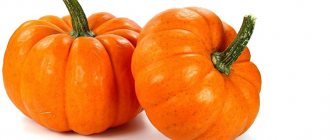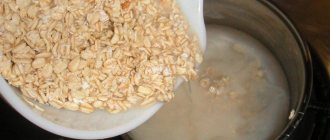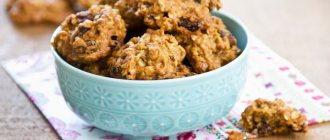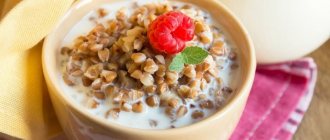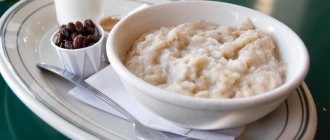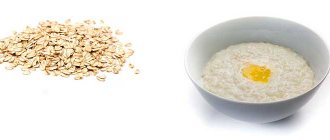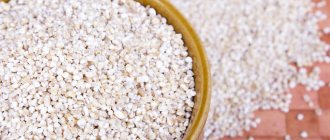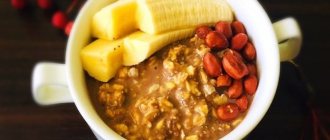Calorie content of all pumpkin porridges in a row:
Didn't find the product or dish you were looking for?
Let us know in a comment and we will add it:
Today we will talk about such a familiar dish as pumpkin porridge. Its calorie content is a subject of interest to those who monitor their body weight or want to lose weight. After all, there are even special “pumpkin” diets designed for these purposes. Don’t forget about the enormous benefits of this vegetable – pumpkin. Let's find out what the calorie content of pumpkin porridge is, what the benefits of pumpkin porridge are and what dietary properties it has.
Pumpkin porridge is recommended by many. It will be useful for those who monitor calories in food, those who suffer from anemia, and those who have any heart problems. This vegetable contains special chemical compounds that help normalize cholesterol levels, make the skin more attractive, improve hair structure, help fight digestive diseases, and changes in blood pressure.
The benefits of pumpkin porridge are most fully manifested when the product is consumed in combination with fats, so it is best to prepare the dish with milk and add butter to it.
The taste and nutritional value of pumpkin porridge is perfectly complemented by the presence of any other components in it, for example, rice or millet.
The benefits of consuming pumpkin pulp are due to the presence of much-needed minerals in it, such as potassium, calcium, magnesium, sodium, and phosphorus. Among the vitamin composition of pumpkin, vitamins A, C, B1, B2, B12, PP, as well as vitamin K, which are practically absent in all other vegetables and fruits, should be noted. A lack of vitamin K in the human body provokes bleeding from the nose, gums and, which is very serious, in internal organs, including the gastrointestinal tract.
In addition, pumpkin pulp contains a lot of pectins - water-soluble dietary fibers that stimulate intestinal motility, help remove radionuclides from the body and help speed up the healing of ulcers. Pumpkin components in combination help remove “bad” cholesterol and normalize water and salt metabolism. Due to this, pumpkin is recommended in any form for cardiovascular diseases, in particular for atherosclerosis and swelling caused by heart failure. And for anemia and exhaustion, it is most beneficial to consume pumpkin pulp - it contains a lot of iron.
Effective diet for weight loss:
They say that there is no better way to lose extra pounds than the pumpkin diet. They also say that such a diet will not only help you lose weight, but also improve your health. Well, considering the benefits of pumpkin for our health, this is not surprising. The specific composition of diets and weight loss methods can be easily found on the Internet. What is typical for all diets is the use of pumpkin not only in the form of porridge or stew, but also in raw form, as well as in the form of fresh juice.
Of course, any raw vegetables and fruits retain significantly more nutrients than those that are heat-treated. But if you include fresh pumpkin in your diet, then you need to remember that this is contraindicated for gastrointestinal diseases, as well as diseases of the pancreas. And in general, before “going on” any diet, you should consult a doctor.
How to prepare this pumpkin porridge at home? Yes, very simple! Here is one of the recipes:
Pumpkin porridge:
- Chopped pumpkin pulp - 800 gr.
- Wheat flour - 100 gr.
- Milk – ½ liter
- Raisins - a handful
- Vanilla - a pinch
- Cinnamon – ½ teaspoon
- Sugar
Millet cereals are washed well, then poured with a large volume of water and brought to a boil. After this, the water is drained, fresh grain is poured in (about 2 fingers higher), and cooked over low heat until it is ready.
The pumpkin is filled with water and boiled until it becomes soft. Then the water is drained and the pumpkin is mashed into a puree using a fork. Pumpkin and millet porridge are combined together.
Then the resulting porridge is poured with milk, washed raisins, vanilla, cinnamon and sugar are added. All this is cooked over low heat (about 5 minutes). That's all! Eat for your health, especially since the low calorie content of pumpkin porridge will not spoil your figure.
More on the same topic:
- Nastena Writes,
Nutritionists recommend eating pumpkin porridge with rice for breakfast. According to them, this dish allows you to maintain a feeling of fullness for a long time. In addition, the human body receives many useful substances from this dish. If you have pumpkin porridge with rice for breakfast, you can do without snacks until lunch.
Julia writes,
I cook millet with pumpkin in water in a pot in the oven. It turns out very tasty, and most importantly satisfying. Kcal is only about 60 per 100 grams. such a mess. I don't put butter in the porridge.
Pumpkin porridge is a simple and healthy dish. The fact is that pumpkin contains a lot of useful vitamins and minerals. In addition, pumpkin porridge helps you lose extra pounds, because pumpkin is a low-calorie vegetable, containing only 28 kcal per 100 g. You can prepare this porridge with different cereals, but pumpkin porridge with rice or millet will be the least high-calorie.
Calorie content and recipe for pumpkin porridge with rice
Pumpkin porridge with rice
- pumpkin – 500 g;
- rice - 7 tablespoons;
- milk – 1 glass.
Cut the pumpkin into small pieces and boil in water until almost done. Add rice to the pumpkin, and at the end of cooking, pour in milk, add salt and sugar. The calorie content of pumpkin porridge with rice will be 353 kcal per 100 g.
Calorie content of pumpkin porridge with millet
If you don't like rice, you can cook pumpkin porridge with millet. This porridge is prepared in the same way as rice porridge. The only difference is that the millet takes a little longer to cook, but the calorie content of such porridge will be slightly lower. 100 g of pumpkin porridge with millet contains 300 kcal.
Lose weight with pumpkin porridge
We found out how many calories are in pumpkin porridge, but if the goal is to become slimmer with its help, you should take into account some nuances. First of all, you should cook porridge not with milk, but with water. 100 g of milk contains 52 kcal, so if you prepare porridge with water, there will be fewer calories, and naturally, the weight loss process will go faster.
In addition, you should not add sugar to pumpkin porridge. Pumpkin is quite sweet on its own, but sugar will not do any good and will add calories.
The process of getting rid of extra pounds will go faster if you eat pumpkin porridge for breakfast. The body will receive enough energy during breakfast and will be satiated for a long period of time, which means that the desire to snack on something harmful will not appear.
Recipe Millet porridge with pumpkin in milk. Calorie, chemical composition and nutritional value.
Nutritional value and chemical composition of “Millet porridge with pumpkin in milk.”
The table shows the nutritional content (calories, proteins, fats, carbohydrates, vitamins and minerals) per 100 grams of edible portion.
| Nutrient | Quantity | Norm** | % of the norm in 100 g | % of the norm in 100 kcal | 100% normal |
| Calorie content | 123.1 kcal | 1684 kcal | 7.3% | 5.9% | 1368 g |
| Squirrels | 4.2 g | 76 g | 5.5% | 4.5% | 1810 |
| Fats | 2.2 g | 56 g | 3.9% | 3.2% | 2545 g |
| Carbohydrates | 21.4 g | 219 g | 9.8% | 8% | 1023 g |
| Organic acids | 0.1 g | ~ | |||
| Alimentary fiber | 1 g | 20 g | 5% | 4.1% | 2000 g |
| Water | 71.3 g | 2273 g | 3.1% | 2.5% | 3188 g |
| Ash | 0.712 g | ~ | |||
| Vitamins | |||||
| Vitamin A, RE | 43 mcg | 900 mcg | 4.8% | 3.9% | 2093 g |
| Retinol | 0.006 mg | ~ | |||
| beta carotene | 0.235 mg | 5 mg | 4.7% | 3.8% | 2128 g |
| Vitamin B1, thiamine | 0.08 mg | 1.5 mg | 5.3% | 4.3% | 1875 |
| Vitamin B2, riboflavin | 0.095 mg | 1.8 mg | 5.3% | 4.3% | 1895 |
| Vitamin B4, choline | 13.52 mg | 500 mg | 2.7% | 2.2% | 3698 g |
| Vitamin B5, pantothenic | 0.314 mg | 5 mg | 6.3% | 5.1% | 1592 g |
| Vitamin B6, pyridoxine | 0.108 mg | 2 mg | 5.4% | 4.4% | 1852 |
| Vitamin B9, folates | 7.084 mcg | 400 mcg | 1.8% | 1.5% | 5647 g |
| Vitamin B12, cobalamin | 0.127 mcg | 3 mcg | 4.2% | 3.4% | 2362 g |
| Vitamin C, ascorbic acid | 0.81 mg | 90 mg | 0.9% | 0.7% | 11111 g |
| Vitamin D, calciferol | 0.019 mcg | 10 mcg | 0.2% | 0.2% | 52632 g |
| Vitamin E, alpha tocopherol, TE | 0.121 mg | 15 mg | 0.8% | 0.6% | 12397 g |
| Vitamin H, biotin | 3.373 mcg | 50 mcg | 6.7% | 5.4% | 1482 g |
| Vitamin K, phylloquinone | 0.5 mcg | 120 mcg | 0.4% | 0.3% | 24000 g |
| Vitamin RR, NE | 1.4056 mg | 20 mg | 7% | 5.7% | 1423 g |
| Niacin | 0.418 mg | ~ | |||
| Macronutrients | |||||
| Potassium, K | 168.44 mg | 2500 mg | 6.7% | 5.4% | 1484 g |
| Calcium, Ca | 80.98 mg | 1000 mg | 8.1% | 6.6% | 1235 g |
| Silicon, Si | 17.464 mg | 30 mg | 58.2% | 47.3% | 172 g |
| Magnesium, Mg | 26.35 mg | 400 mg | 6.6% | 5.4% | 1518 g |
| Sodium, Na | 35.09 mg | 1300 mg | 2.7% | 2.2% | 3705 g |
| Sera, S | 36.17 mg | 1000 mg | 3.6% | 2.9% | 2765 g |
| Phosphorus, P | 104.2 mg | 800 mg | 13% | 10.6% | 768 g |
| Chlorine, Cl | 72.62 mg | 2300 mg | 3.2% | 2.6% | 3167 g |
| Microelements | |||||
| Aluminium, Al | 55.4 mcg | ~ | |||
| Bor, B | 45.5 mcg | ~ | |||
| Vanadium, V | 41.54 mcg | ~ | |||
| Iron, Fe | 0.658 mg | 18 mg | 3.7% | 3% | 2736 g |
| Yod, I | 5.01 mcg | 150 mcg | 3.3% | 2.7% | 2994 g |
| Cobalt, Co | 2.296 mcg | 10 mcg | 23% | 18.7% | 436 g |
| Lithium, Li | 1.389 mcg | ~ | |||
| Manganese, Mn | 0.1864 mg | 2 mg | 9.3% | 7.6% | 1073 g |
| Copper, Cu | 107.53 mcg | 1000 mcg | 10.8% | 8.8% | 930 g |
| Molybdenum, Mo | 7.134 mcg | 70 mcg | 10.2% | 8.3% | 981 g |
| Nickel, Ni | 2.135 mcg | ~ | |||
| Tin, Sn | 11.24 mcg | ~ | |||
| Rubidium, Rb | 15.3 mcg | ~ | |||
| Selenium, Se | 1.065 mcg | 55 mcg | 1.9% | 1.5% | 5164 g |
| Strontium, Sr | 33.94 mcg | ~ | |||
| Titanium, Ti | 3.86 mcg | ~ | |||
| Fluorine, F | 26.24 mcg | 4000 mcg | 0.7% | 0.6% | 15244 g |
| Chromium, Cr | 1.9 mcg | 50 mcg | 3.8% | 3.1% | 2632 g |
| Zinc, Zn | 0.6083 mg | 12 mg | 5.1% | 4.1% | 1973 |
| Zirconium, Zr | 1.89 mcg | ~ | |||
| Digestible carbohydrates | |||||
| Starch and dextrins | 12.489 g | ~ | |||
| Mono- and disaccharides (sugars) | 8.9 g | max 100 g | |||
| Glucose (dextrose) | 0.467 g | ~ | |||
| Sucrose | 0.301 g | ~ | |||
| Fructose | 0.206 g | ~ | |||
| Essential amino acids | |||||
| Arginine* | 0.084 g | ~ | |||
| Valin | 0.092 g | ~ | |||
| Histidine* | 0.051 g | ~ | |||
| Isoleucine | 0.084 g | ~ | |||
| Leucine | 0.298 g | ~ | |||
| Lysine | 0.056 g | ~ | |||
| Methionine | 0.058 g | ~ | |||
| Methionine + Cysteine | 0.094 g | ~ | |||
| Threonine | 0.078 g | ~ | |||
| Tryptophan | 0.035 g | ~ | |||
| Phenylalanine | 0.113 g | ~ | |||
| Phenylalanine+Tyrosine | 0.193 g | ~ | |||
| Nonessential amino acids | |||||
| Alanin | 0.208 g | ~ | |||
| Aspartic acid | 0.127 g | ~ | |||
| Glycine | 0.058 g | ~ | |||
| Glutamic acid | 0.432 g | ~ | |||
| Proline | 0.158 g | ~ | |||
| Serin | 0.136 g | ~ | |||
| Tyrosine | 0.08 g | ~ | |||
| Cysteine | 0.035 g | ~ | |||
| Sterols (sterols) | |||||
| Cholesterol | 4.45 mg | max 300 mg | |||
| Saturated fatty acids | |||||
| Saturated fatty acids | 1 g | max 18.7 g | |||
| 14:0 Miristinovaya | 0.002 g | ~ | |||
| 16:0 Palmitinaya | 0.047 g | ~ | |||
| 18:0 Stearic | 0.01 g | ~ | |||
| 20:0 Arakhinovaya | 0.004 g | ~ | |||
| Monounsaturated fatty acids | 0.592 g | min 16.8 g | 3.5% | 2.8% | |
| 16:1 Palmitoleic | 0.002 g | ~ | |||
| 18:1 Oleic (omega-9) | 0.101 g | ~ | |||
| Polyunsaturated fatty acids | 0.399 g | from 11.2 to 20.6 g | 3.6% | 2.9% | |
| 18:2 Linolevaya | 0.356 g | ~ | |||
| 18:3 Linolenic | 0.006 g | ~ | |||
| Omega-6 fatty acids | 0.4 g | from 4.7 to 16.8 g | 8.5% | 6.9% |
The energy value of millet porridge with pumpkin in milk is 123.1 kcal.
- Serving = 154 g (189.6 kcal)
Primary Source: Created in the application by the user. Read more.
** This table shows the average levels of vitamins and minerals for an adult. If you want to know the norms taking into account your gender, age and other factors, then use the “My Healthy Diet” application.
What is the calorie content of millet porridge per 100 grams?
Cereals have taken one of the most important places in the healthy nutrition menu . Millet cereal is one of the five most recommended. Of all the cereals, it is the most traditional for Russia . Millet has a bright yellow color and a crumbly consistency, so it just begs to be served on the table ! Made from millet, the vitamins and microelements contained in the cereal provide great health benefits.
Lifehacks for cooking millet porridge
- Before cooking millet cereals, rinse them under running water to remove grain dust particles. There is no need to rinse the flakes.
- If you cook porridge in water and want a crumbly consistency, add a little butter during cooking.
- Choose a pan with thick walls, this will minimize the risk of the porridge burning.
- Nuts, dried fruits, jam, and cream go well with millet porridge.
- To prevent the porridge from boiling over and the milk from running away, place a wooden spoon on the side of the pan.
Benefit
What are the benefits of millet porridge? Millet is rich in potassium, which strengthens the circulatory system, promotes the removal of toxins and the elasticity of blood vessels, and also has a beneficial effect on the liver. Millet prevents the deposition of fatty tissue, so an effective way to lose weight is to arrange fasting days on millet.
Due to its fiber content, millet normalizes intestinal microflora and relieves constipation.
| Name | Content | Daily requirement % |
| B2 (riboflavin) | 0.04 mg | 2 |
| B6 (pyridoxine) | 0.52 mg | 26 |
| Fe (iron) | 2.7 mg | 18 |
| Cu (copper) | 0.37 mg | 24 |
Millet is also rich in cobalt, chromium, zinc, magnesium and potassium. Its benefits are known for diabetes, cardiovascular and pancreatic diseases, atherosclerosis and liver. Benefits for bones and teeth due to sufficient silicon and fluorine content. Millet helps remove traces of medications from the body. It contains a lot of “slow” carbohydrates, which helps speed up metabolism and burn excess fat, and the benefit of copper is that it improves the elasticity of muscle fibers.
Before cooking, porridge should be rinsed with warm water, otherwise it will become bitter. This is due to the high fat content in millet grains, which quickly oxidizes.
Millet recipe with pumpkin. Calorie, chemical composition and nutritional value.
Nutritional value and chemical composition of “Millet with pumpkin”.
The table shows the nutritional content (calories, proteins, fats, carbohydrates, vitamins and minerals) per 100 grams of edible portion.
| Nutrient | Quantity | Norm** | % of the norm in 100 g | % of the norm in 100 kcal | 100% normal |
| Calorie content | 99.9 kcal | 1684 kcal | 5.9% | 5.9% | 1686 g |
| Squirrels | 3.9 g | 76 g | 5.1% | 5.1% | 1949 |
| Fats | 1.2 g | 56 g | 2.1% | 2.1% | 4667 g |
| Carbohydrates | 18.4 g | 219 g | 8.4% | 8.4% | 1190 g |
| Organic acids | 0.1 g | ~ | |||
| Alimentary fiber | 2.2 g | 20 g | 11% | 11% | 909 g |
| Water | 73.3 g | 2273 g | 3.2% | 3.2% | 3101 g |
| Ash | 0.804 g | ~ | |||
| Vitamins | |||||
| Vitamin A, RE | 184 mcg | 900 mcg | 20.4% | 20.4% | 489 g |
| Retinol | 0.006 mg | ~ | |||
| beta carotene | 1.07 mg | 5 mg | 21.4% | 21.4% | 467 g |
| Vitamin B1, thiamine | 0.104 mg | 1.5 mg | 6.9% | 6.9% | 1442 g |
| Vitamin B2, riboflavin | 0.086 mg | 1.8 mg | 4.8% | 4.8% | 2093 g |
| Vitamin B4, choline | 11.8 mg | 500 mg | 2.4% | 2.4% | 4237 g |
| Vitamin B5, pantothenic | 0.482 mg | 5 mg | 9.6% | 9.6% | 1037 g |
| Vitamin B6, pyridoxine | 0.163 mg | 2 mg | 8.2% | 8.2% | 1227 g |
| Vitamin B9, folates | 9.969 mcg | 400 mcg | 2.5% | 2.5% | 4012 g |
| Vitamin B12, cobalamin | 0.115 mcg | 3 mcg | 3.8% | 3.8% | 2609 g |
| Vitamin C, ascorbic acid | 2.36 mg | 90 mg | 2.6% | 2.6% | 3814 g |
| Vitamin E, alpha tocopherol, TE | 0.355 mg | 15 mg | 2.4% | 2.4% | 4225 g |
| Vitamin H, biotin | 1.713 mcg | 50 mcg | 3.4% | 3.4% | 2919 g |
| Vitamin K, phylloquinone | 1 mcg | 120 mcg | 0.8% | 0.8% | 12000 g |
| Vitamin RR, NE | 1.3857 mg | 20 mg | 6.9% | 6.9% | 1443 g |
| Niacin | 0.641 mg | ~ | |||
| Betaine | 0.196 mg | ~ | |||
| Macronutrients | |||||
| Potassium, K | 216.01 mg | 2500 mg | 8.6% | 8.6% | 1157 g |
| Calcium, Ca | 49.89 mg | 1000 mg | 5% | 5% | 2004 |
| Silicon, Si | 36.852 mg | 30 mg | 122.8% | 122.9% | 81 g |
| Magnesium, Mg | 29.91 mg | 400 mg | 7.5% | 7.5% | 1337 g |
| Sodium, Na | 15.26 mg | 1300 mg | 1.2% | 1.2% | 8519 g |
| Sera, S | 36.84 mg | 1000 mg | 3.7% | 3.7% | 2714 g |
| Phosphorus, P | 86.5 mg | 800 mg | 10.8% | 10.8% | 925 g |
| Chlorine, Cl | 18.8 mg | 2300 mg | 0.8% | 0.8% | 12234 g |
| Microelements | |||||
| Aluminium, Al | 56.4 mcg | ~ | |||
| Bor, B | 60.1 mcg | ~ | |||
| Vanadium, V | 98.36 mcg | ~ | |||
| Iron, Fe | 0.855 mg | 18 mg | 4.8% | 4.8% | 2105 g |
| Yod, I | 0.92 mcg | 150 mcg | 0.6% | 0.6% | 16304 g |
| Cobalt, Co | 2.461 mcg | 10 mcg | 24.6% | 24.6% | 406 g |
| Lithium, Li | 1.553 mcg | ~ | |||
| Manganese, Mn | 0.2311 mg | 2 mg | 11.6% | 11.6% | 865 g |
| Copper, Cu | 207.09 mcg | 1000 mcg | 20.7% | 20.7% | 483 g |
| Molybdenum, Mo | 7.148 mcg | 70 mcg | 10.2% | 10.2% | 979 g |
| Nickel, Ni | 4.986 mcg | ~ | |||
| Tin, Sn | 2.11 mcg | ~ | |||
| Rubidium, Rb | 56.9 mcg | ~ | |||
| Selenium, Se | 1.215 mcg | 55 mcg | 2.2% | 2.2% | 4527 g |
| Strontium, Sr | 26.1 mcg | ~ | |||
| Titanium, Ti | 4.31 mcg | ~ | |||
| Fluorine, F | 65.8 mcg | 4000 mcg | 1.6% | 1.6% | 6079 g |
| Chromium, Cr | 1.89 mcg | 50 mcg | 3.8% | 3.8% | 2646 g |
| Zinc, Zn | 0.6356 mg | 12 mg | 5.3% | 5.3% | 1888 |
| Zirconium, Zr | 2.11 mcg | ~ | |||
| Digestible carbohydrates | |||||
| Starch and dextrins | 14.073 g | ~ | |||
| Mono- and disaccharides (sugars) | 4.4 g | max 100 g | |||
| Galactose | 0.004 g | ~ | |||
| Glucose (dextrose) | 2.035 g | ~ | |||
| Lactose | 1.092 g | ~ | |||
| Maltose | 0.002 g | ~ | |||
| Sucrose | 0.63 g | ~ | |||
| Fructose | 0.756 g | ~ | |||
| Essential amino acids | |||||
| Arginine* | 0.114 g | ~ | |||
| Valin | 0.149 g | ~ | |||
| Histidine* | 0.078 g | ~ | |||
| Isoleucine | 0.131 g | ~ | |||
| Leucine | 0.402 g | ~ | |||
| Lysine | 0.123 g | ~ | |||
| Methionine | 0.084 g | ~ | |||
| Methionine + Cysteine | 0.105 g | ~ | |||
| Threonine | 0.118 g | ~ | |||
| Tryptophan | 0.048 g | ~ | |||
| Phenylalanine | 0.164 g | ~ | |||
| Phenylalanine+Tyrosine | 0.216 g | ~ | |||
| Nonessential amino acids | |||||
| Alanin | 0.258 g | ~ | |||
| Aspartic acid | 0.203 g | ~ | |||
| Glycine | 0.08 g | ~ | |||
| Glutamic acid | 0.645 g | ~ | |||
| Proline | 0.247 g | ~ | |||
| Serin | 0.196 g | ~ | |||
| Tyrosine | 0.126 g | ~ | |||
| Cysteine | 0.044 g | ~ | |||
| Sterols (sterols) | |||||
| Cholesterol | 1.74 mg | max 300 mg | |||
| Fatty acid | |||||
| Trans fats | 0.019 g | max 1.9 g | |||
| monounsaturated trans fats | 0.017 g | ~ | |||
| Saturated fatty acids | |||||
| Saturated fatty acids | 0.4 g | max 18.7 g | |||
| 4:0 Oil | 0.017 g | ~ | |||
| 6:0 Kapronovaya | 0.009 g | ~ | |||
| 8:0 Caprylic | 0.004 g | ~ | |||
| 10:0 Kaprinovaya | 0.011 g | ~ | |||
| 12:0 Lauric | 0.012 g | ~ | |||
| 14:0 Miristinovaya | 0.04 g | ~ | |||
| 15:0 Pentadecane | 0.004 g | ~ | |||
| 16:0 Palmitinaya | 0.174 g | ~ | |||
| 17:0 Margarine | 0.002 g | ~ | |||
| 18:0 Stearic | 0.064 g | ~ | |||
| 20:0 Arakhinovaya | 0.005 g | ~ | |||
| Monounsaturated fatty acids | 0.236 g | min 16.8 g | 1.4% | 1.4% | |
| 14:1 Myristoleic | 0.003 g | ~ | |||
| 15:1 Pentadecene | 0.001 g | ~ | |||
| 16:1 Palmitoleic | 0.008 g | ~ | |||
| 16:1 cis | 0.006 g | ~ | |||
| 17:1 Heptadecene | 0.001 g | ~ | |||
| 18:1 Oleic (omega-9) | 0.224 g | ~ | |||
| 18:1 cis | 0.094 g | ~ | |||
| 18:1 trans | 0.017 g | ~ | |||
| Polyunsaturated fatty acids | 0.417 g | from 11.2 to 20.6 g | 3.7% | 3.7% | |
| 18:2 Linolevaya | 0.412 g | ~ | |||
| 18:2 mixed isomers | 0.002 g | ~ | |||
| 18:2 Omega-6, cis, cis | 0.012 g | ~ | |||
| 18:3 Linolenic | 0.008 g | ~ | |||
| 18:3 Omega-3, alpha-linolenic | 0.002 g | ~ | |||
| 20:3 Eicosatriene | 0.001 g | ~ | |||
| Omega-6 fatty acids | 0.4 g | from 4.7 to 16.8 g | 8.5% | 8.5% |
The energy value of millet with pumpkin is 99.9 kcal.
- Serving = 230 g (229.8 kcal)
Primary Source: Created in the application by the user. Read more.
** This table shows the average levels of vitamins and minerals for an adult. If you want to know the norms taking into account your gender, age and other factors, then use the “My Healthy Diet” application.
Millet porridge with pumpkin in milk: benefits, calorie content
Millet was especially popular in ancient times. It is known that porridge fills you up like nothing else. The complex carbohydrates that millet porridge contains are broken down slowly and also provide the body with the necessary energy in portions. At the same time, it has dietary properties and promotes weight loss.
Also millet porridge with milk:
- has enveloping and softening effects;
- has a positive effect on the condition of the mucous membranes of the gastrointestinal tract;
- normalizes digestion, prevents constipation;
- cleanses the body of harmful substances.
Photo source: lady.tochka.net
Millet is so beneficial due to the presence in its composition:
- amino acids - elements for building skin and muscle cells;
- vitamins B, E, carotenoids;
- vegetable fiber;
- microelements (phosphorus, iron, magnesium compounds).
Finally, when porridge with pumpkin is included in one set, the result is an even more fortified dish. Pumpkin pieces give the porridge an attractive appearance and a delicate sweet taste.
Photo source: svoimirykami.club
One serving of calorie content (100 g of porridge with water) reaches 93 kcal. It varies depending on the additional ingredients:
- serving with added oil - 115 kcal;
- serving with added sugar or pumpkin - 123 kcal.
Millet porridge with pumpkin and water benefits. Millet porridge with pumpkin on water beneficial properties
Benefits, harms and delicious recipes for millet porridge
Currently, due to the variety of food consumed, people eat porridge in small quantities. And completely in vain!
Porridge has always been considered the main food in Rus'. Millet was especially popular.
It was prepared in various ways. For example, in the form of kulesh soup. Now this recipe is practically not used.
If it was porridge, then it was cooked with the addition of bacon, mushrooms, pumpkin, milk, and cottage cheese. The calorie content of the dish depends on the added ingredients, and this is important for many people.
In order to once again revive interest in millet porridge, we will tell you what its benefits and harms are, how to use it correctly, and describe the most delicious recipes. And you, dear readers, draw the appropriate conclusions!
How to cook millet porridge with pumpkin in milk
Millet porridge with pumpkin for two is prepared from the following ingredients:
- millet cereal - 1 cup;
- pumpkins - 300 g;
- milk, water - 2 glasses each;
- butter - 50 g;
- salt, sugar - to taste.
The fastest way to cook millet porridge with pumpkin is to cook all the ingredients together. You can, of course, make pumpkin puree first, but sliced pumpkin looks harmonious in this dish.
Photo source: lady.tochka.net
Actually, the process of preparing a healthy breakfast consists of the following steps:
- Millet cereals are sorted and washed until the water is clear.
- The pumpkin pulp is peeled and seeds removed and cut into cubes.
- Place the cereal and pumpkin in a saucepan, add water, add salt and cook over high heat until the water boils away. At the same time, constantly skim off the foam, but do not stir. The millet should not have time to boil.
- As soon as there is no water left in the pan, add warm milk.
- Close the pan and finish cooking the porridge.
- Add butter and sugar to the finished dish.
If time permits, the porridge can be simmered in the oven for about half an hour. So its taste will become even brighter and richer.
What are the benefits of millet porridge with pumpkin?
How many calories are in millet porridge with pumpkin in milk, what beneficial properties it has, all this is of great interest to those who lead a healthy lifestyle and monitor their health and figure. So we will try to answer these questions in the next article.
So here it is:
Pumpkin pulp is rich in malic, pantothenic and folic acids, sugars, carotene, vitamins E, K, PP, potassium, calcium, iron, phosphorus, copper, zinc, cobalt, and fluorine salts. Its seeds are an excellent source of protein, monounsaturated fats and healthy minerals. Just 50 grams of pumpkin seeds contain 67% of the daily value of magnesium, 45% of manganese, 40% of iron, 23% of zinc and 20% of copper.
Its orange-fleshed fruits are an important source of carotene. For better absorption of this fat-soluble vitamin, which is converted into vitamin A in the body, it is necessary to add milk and butter to dishes with pumpkin. This vitamin is valuable for people susceptible to cardiovascular and infectious diseases. It is in dire need of pregnant women, nursing mothers, children, as well as people whose eyesight is subject to constant strain: drivers, watchmakers, people working on a computer.
Little secrets of a healthy breakfast
What could be better for breakfast than millet porridge with pumpkin and milk? Even our distant ancestors considered this dish a real source of energy and health. And for such porridge to become your household’s favorite breakfast, it needs to be prepared correctly. Here's what experienced housewives advise:
- When choosing millet, pay attention to its color. The grains should be large and uniformly yellowish in color. If you purchase a stale product, the porridge will taste bitter.
- You need to choose a sweet variety of pumpkin with a bright yellow, almost orange color - this way the dish will turn out not only more healthy and tasty, but also very bright and beautiful.
- Before cooking, the millet must be sorted.
- To prevent the porridge from becoming bitter, the cereal must be washed in seven waters: six times in cold water and once in hot water.
- Don’t be afraid to overdo it with the liquid, because you can always drain it at the end of cooking.
- To make the cooking process easier, millet porridge can be cooked in a slow cooker.
- The dish can be complemented with fruit and berry notes. Chopped nuts or raisins are also added to the porridge.
Those who are afraid of gaining extra pounds are recommended to eat millet porridge with pumpkin in milk for breakfast, since its calorie content is 100-120 kcal, which can easily be spent before lunch.
We prepare delicious porridge for the whole family
In the classic version, millet porridge with pumpkin and milk is prepared in a saucepan. We offer a simple recipe for this wonderful dish.
Compound:
- 0.5 kg pumpkin pulp;
- 200 g millet;
- 3 tbsp. milk;
- 150 g granulated sugar;
- raisins - to taste;
- 50-70 g butter;
- salt.
Preparation:
- Let's prepare the millet. We rinse it first in cold water, and the liquid in the container should be several times more than the cereal.
- Now put the millet in a colander and pour boiling water over it thoroughly. If this is not done, the porridge may turn out bitter.
- Then we clean the pumpkin, cut it into small cubes and put it in a saucepan.
- Pour milk over the pumpkin pieces and cook over low heat for 20 minutes, remembering to stir.
- When the milk is hot, add granulated sugar and butter to the pan, as well as salt to taste.
- After the specified time, add millet, mix and cook until tender. This usually takes about 15 minutes.
- When the porridge is ready, add raisins to it and mix. You can serve the dish to the table.
How many calories does it have?
Here's how much:
Prepare porridge according to this recipe:
Products (for 4 servings):
- Millet groats – 250 g. – (870 kcal)
- Pumpkin – 150 g. – (70 kcal)
- Milk - 3 glasses. — (364 kcal)
- Water - 2 glasses.
- Salt - 0.25 tsp. (taste).
- Sugar - 2 tbsp. l. (taste). — (93 kcal)
- Butter - to taste. — 20 g — (150 kcal)
How to cook:
- We sort the millet, rinse it several times with cold water, pour boiling water over it to remove any bitterness, and rinse it again.
- Pour the millet into a saucepan with water, put it on the fire, let it boil, removing the foam, cook the porridge over medium heat until the water boils.
- We grate the pumpkin on a fine grater so that it cooks faster and does not need to be cooked separately and add it to the porridge, along with salt and sugar.
- Pour in milk.
- After boiling, reduce the heat to low and cook the porridge, stirring regularly for about 15 minutes. Turn off the heat and let the porridge brew under the lid for 5 minutes.
- Serve porridge with butter.
Based on the posted recipe:
The calorie content of millet porridge with pumpkin in milk, per 100 grams, is:
Crumbly and aromatic porridge from a pot
Millet porridge with pumpkin pulp can also be prepared in the oven. This recipe is ideal because you don’t have to stand at the stove and make sure that the porridge doesn’t burn and the milk doesn’t “run away.” And if you are preparing porridge for children, add dried fruits or candied fruits.
Compound:
- 300 g millet;
- 250 g pumpkin pulp;
- 1 liter of milk;
- salt;
- granulated sugar;
- butter.
Preparation:
- We prepare millet in a way already known to us.
- Peel and cut the pumpkin. By the way, this can be done in a simple and interesting way: extract the pumpkin pulp with a spoon.
- Take a clay pot and place most of the pumpkin pieces on the bottom so that they occupy about half of it. Add granulated sugar and salt to taste.
- Now we lay out the millet.
- Place the remaining pumpkin pulp on top and pour in milk.
- Close the pot and place in an oven preheated to 180-190 degrees. Bake for 40 minutes, then remove the lid and simmer the porridge for another 10-15 minutes until it browns.
How to cook millet porridge from cereals in water?
Millet porridge must be cooked in water in proportions of 1:3, and to make the porridge crumbly at the end of cooking, add a little butter to the pan.
Ingredients for 1 serving:
- 1/2 cup millet
- 1.5 glasses of water
- sugar to taste
- a pinch of salt
- butter
Cooking method:
Add cereal to the pan, add water and bring to a boil, stir constantly, add sugar and salt. Cook for about 30 minutes until done. Add butter to the finished porridge and leave to steep under the lid for 5–10 minutes.
Millet porridge with pumpkin pulp in a slow cooker
Using a multicooker, cooking millet porridge with pumpkin in milk is as easy as shelling pears. We only need to put all the components into the multi-bowl, and our miracle assistant will do the rest for us. And if you want to add aromatic notes to the dish, add a pinch of vanilla.
Compound:
Preparation:
- Let's prepare the millet as in previous recipes.
- Peel the pumpkin and cut out the thick fibers. Cut the pumpkin pulp into small even cubes.
- Place millet and pumpkin pulp in a multi-bowl. Pour in milk and add granulated sugar and vanilla. You can add a little salt.
- We set the “Porridge” program on the multicooker and the cooking time is half an hour.
- At the end of the program, we try the porridge, if necessary, add a little more time. If you like thin porridge, add more milk.
- Tasty and healthy porridge is ready. Bon appetit!
